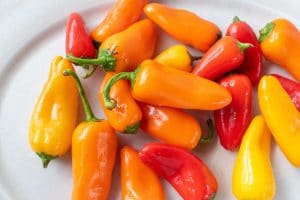What’s The Difference Between Salami And Pepperoni?
Important Note: When you buy through our links, we may earn a commission. As an Amazon Associate we earn from qualifying purchases. Content, pricing, offers and availability are subject to change at any time - more info.
If you’re a lover of Italian-style cuisine, you probably enjoy salami and pepperoni. Both are delicious, spicy sausages, best eaten sliced as a luscious stuffing for a sub or sandwich, or as a topping for pizza. What is the difference between these two tasty sausages?
Salami and pepperoni have different origins, ingredients, taste, texture, and ways of being served. Salami is the generic name for cured, dried Italian-style sausage, made from beef, pork, poultry, and veal. Pepperoni is an American salami variant, made from beef and pork and spiced with peppers.
Although salami and pepperoni are very similar and can often be used interchangeably in recipes, there are distinct differences between the two types of sausage, primarily in flavor and texture, because of their differing histories, ingredients, and uses.
The Differences Between Salami And Pepperoni
Salami is a dried, cured sausage, usually made of beef and pork, typical of Italian cuisine. One type of salami is pepperoni, which was invented in America.
Pepperoni is a kind of salami, so it has a lot in common with the Italian sausage, including its manufacture. However, there are some fundamental differences.
| Salami | Pepperoni | |
| Origin | Italy | United States |
| Ingredients | Pork, beef, poultry, veal, white pepper, vinegar, garlic, herbs, minced fat, salt, sodium nitrate | Pork, beef, paprika, chili pepper, garlic, fennel, cayenne pepper, paprika, white pepper, anise seed, salt, sodium nitrite |
| Flavor | Rich, ranging from robust and sour to sweet and delicate | Smoky, peppery |
| Texture | Coarse or fine-grained Can be dry or soft | Fine-grained Soft |
| Best served | Antipasto, lunch meat, pasta | Pizza topping |
| Calories (per 3 oz serving) | 419 | 540 |
What Is Salami?
Salami is a cured, sometimes fermented, and sometimes smoked sausage made from a mixture of pork, beef, veal, and poultry. It is spiced and salted and then air-dried. The name “salami” comes from the Italian word for salt, “salare.”
History Of Salami
The process of salting, fermenting and curing meat to preserve it is an ancient one, dating back thousands of years.
Food historians suggest that salami was developed in Roman times and spread across Europe with the Roman Empire. The earliest forms of salami were made from pork and salt stuffed into a sausage casing (often an animal intestine) and then dried.
This process preserved the sausage, which was said to last up to 40 days, which was necessary especially for poor people or for traveling soldiers who did not always have access to fresh meat or modern refrigeration methods.
Although salami is typically Italian, there are local versions of this sausage in almost every European country, including France, Germany, Romania, and Spain.
Today, salami is famous throughout the world as a feature of Italian cuisine and as a pizza, sandwich, and pasta ingredient.
How Is Salami Made?
The method of making salami has remained unchanged for centuries.
Salami combines minced pork, veal, beef, minced fat, and sometimes poultry or venison – and even donkey or horse meat, particularly in France. The butcher then adds spices, including salt, vinegar, white pepper, black pepper, minced fat, herbs, and garlic.
The minced fat gives salami its traditionally marbled appearance – and makes it a high-calorie ingredient as well.
The combination of meat types and spices will differ, depending on the variant being made. These variations can be national, local, or even individual family recipes.
The meat mixture is then stuffed into sausage casings and shaped.
Salami then goes through a process of fermentation by hanging the sausages in warm, dry conditions. Fermenting salami means healthy bacteria develop outside the sausage, preventing harmful bacteria and giving it a typical sour flavor. However, hygiene and health and safety standards mean that most modern salami has sodium nitrate added as a chemical preservative.
The salami is then moved to a cool environment to dry and cure. Air-drying means that the salami hardens as moisture evaporates.
Once the salami has cured, it is ready for eating.
How To Prepare and Serve Salami
Because salami is a cured sausage, you can eat it as is, without cooking. Usually sliced thinly and served cold, salami has many uses in the kitchen.
Salami would form part of a cold antipasto platter in traditional Italian cuisine, often served at lunchtime or as a sandwich filling. However, salami can also form part of recipes for soups, pasta sauces, salads, and, of course, pizza.
Types Of Salami
There are variants of salami from all over Italy and all over Europe. Here are some favorite styles of salami.
Italian Salami
- Genovese salami is characterized by the use of fennel seeds and wine.
- Milanese salami is a sweet, fine-grained salami.
- Finocchiona salami is a spicy Tuscan salami spiced with fennel and black pepper.
- Soppressata salami is cured, pressed pork, and spiced with garlic, pepper, fennel, oregano, and basil.
French Salami
French salami is a thicker pork sausage, often eaten with dried fruit, wine, and cheese.
German Salami
Although also made from pork, beef, garlic, and spices, German salami is a fattier and less robust salami.
Hungarian Salami
The characteristic fattiness of Hungarian salami comes from the use of pork and pork belly as ingredients.
Spanish Salami
Spanish salami is finely ground and combines pork, beef, and peppercorns. This variant of salami is not the same as chorizo, a cured sausage with similar origins but which is always made with pimento or spiced paprika.
What Is Pepperoni?
Pepperoni is an American variant of salami, made with chili and other peppers and usually served on pizza.
History Of Pepperoni
When Italian immigrants traveled to the United States in the late nineteenth and early twentieth centuries, they brought their cuisine, recipes, and ingredients, including salami.
Legend has it that an Italian-American butcher in New York, perhaps missing the spicy salami typical of his hometown Naples (salsiccia Napoletana picante), developed pepperoni, a salami flavored with peppers in the late 1890s.
The word “pepperoni” comes from the Italian “peperone,” meaning bell pepper. However, pepperoni’s pepperiness comes from chili peppers, and perhaps the creator gave the new sausage this name to warn buyers that this wasn’t the usual mild salami.
The popularity of the new style of salami spread and, by the 1920s, was a typical American pizza topping.
Today, there are as many pepperoni variants as there are salami variants, and Americans consume 250 million pounds of sausage per year.
How Is Pepperoni Made?
Being a kind of salami, pepperoni is produced in the same way as other salamis: through mixing meat and spices, then stuffing and shaping the sausage, and fermenting and air-drying to cure the sausage.
The significant difference is not in the method of making pepperoni but in the ingredients. Traditionally, pepperoni is made from a combination of pork and beef. It needs to be labeled clearly if it is only made from beef or poultry, such as turkey pepperoni.
The other vital ingredient difference is the addition of chili to pepperoni. The high ratio of cayenne pepper, chili pepper, or paprika to meat gives pepperoni its deeper, smokier, spicier flavor than traditional salami.
How To Prepare and Serve Pepperoni
Like salami, you can eat pepperoni sliced without cooking, and it makes a zesty snack.
However, while salami is well-known as a sandwich ingredient, the most common use of pepperoni is as a pizza topping. In fact, pepperoni is the most popular pizza topping in the United States, served on nearly 40% of all pizzas served.
Conclusion
Salami and pepperoni are both cured, spicy sausage. Salami is the generic name for sausage style, while pepperoni is a version of salami developed in the United States by Italian immigrants. Both contain minced pork and beef and are similarly spiced. However, pepperoni typically contains chili or cayenne pepper and has a more delicate texture and smokier, spicier flavor than salami, hence its popularity as a pizza topping.
























